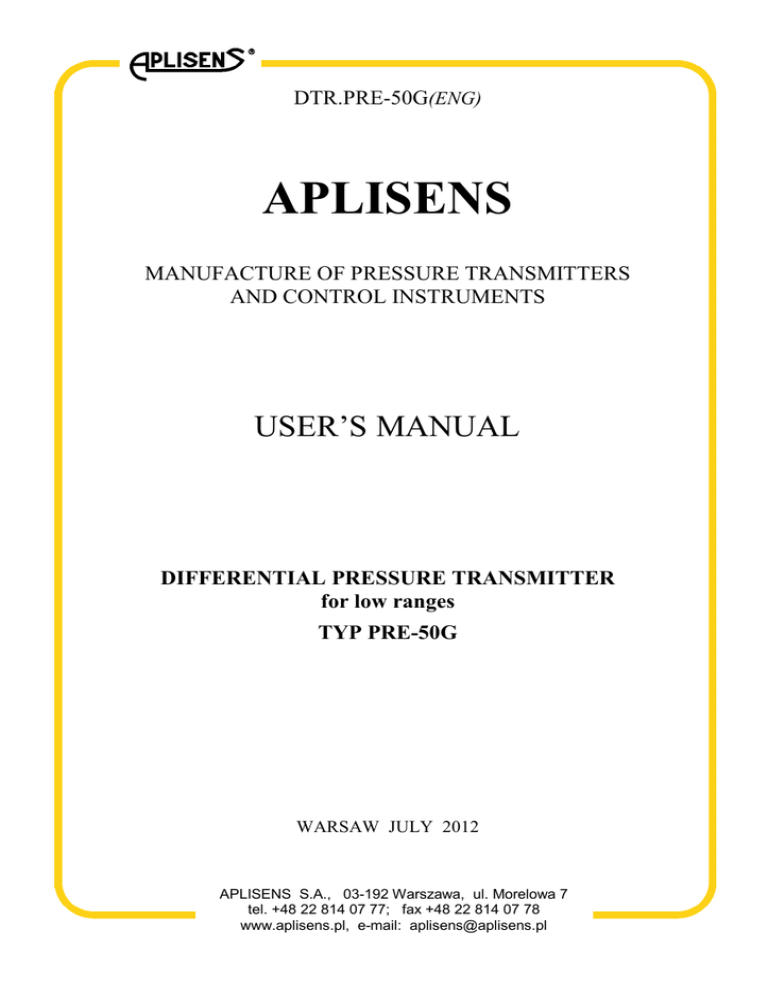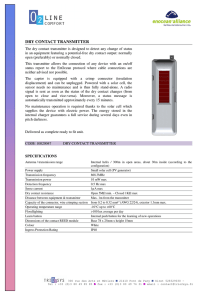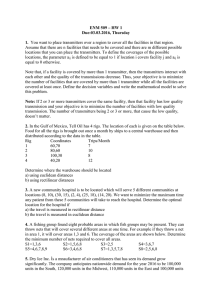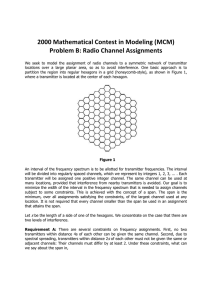- Aplisens
advertisement

DTR.PRE-50G(ENG) APLISENS MANUFACTURE OF PRESSURE TRANSMITTERS AND CONTROL INSTRUMENTS USER’S MANUAL DIFFERENTIAL PRESSURE TRANSMITTER for low ranges TYP PRE-50G WARSAW JULY 2012 APLISENS S.A., 03-192 Warszawa, ul. Morelowa 7 tel. +48 22 814 07 77; fax +48 22 814 07 78 www.aplisens.pl, e-mail: aplisens@aplisens.pl Symbols used Symbol Description Warning to proceed strictly in accordance with the information contained in the documentation in order to ensure the safety and full functionality of the device. i Information particularly useful during installation and operation of the device. Information on disposal of used equipment PODSTAWOWE WYMAGANIA I BEZPIECZEŃSTWO UŻYTKOWANIA - The manufacturer will not be liable for damage resulting from incorrect installation, failure to maintain the device in a suitably functional condition, or use of the device other than for its intended purpose - Installation should be carried out by qualified personnel having the necessary authorisation to install electrical and pressure measuring devices. The installer is responsible for performing the installation in accordance with these instructions and with the electromagnetic compatibility and safety regulations and standards applicable to the type of installation. - In systems with pressure transmitters there exists, in case of leakage, a risk to personnel on the side where the medium is under pressure. All safety and protection requirements must be observed during installation, operation and inspections. - If a device is not functioning correctly, disconnect it and send it for repair to the manufacturer or to a firm authorised by the manufacturer. In order to minimise the risk of malfunction and associated risks to personnel, the device is not to be installed or used in particularly hostile conditions, where the following risks occur: - possibility of mechanical impacts, excessive shocks and vibration; - excessive temperature fluctuation; - condensation of water vapour, dust, icing. The manufacturer reserves the right to make changes (not having a negative impact on the operational parameters of the products) without updating the contents of the technical manual. 1 DTR.PRE-50G(ENG) CONTENTS 1. INTRODUCTION................................................................................................................................. 2 2. USER INFORMATION ........................................................................................................................ 2 3. APPLICATIONS AND MAIN FEATURES ........................................................................................... 2 4. IDENTIFYING MARKS / ORDERING PROCEDURE .......................................................................... 2 5. TECHNICAL DATA ............................................................................................................................ 2 5.1. MEASUREMENT RANGES............................................................................................................................................... 2 5.2. OPERATIONAL PARAMETERS ......................................................................................................................................... 2 5.3. ELECTRICAL PARAMETERS............................................................................................................................................ 3 5.4. PERMITTED ENVIRONMENTAL CONDITIONS ..................................................................................................................... 3 5.5. CONSTRUCTION MATERIALS .......................................................................................................................................... 3 5.6. PRESSURE CONNECTORS ............................................................................................................................................ 3 5.7. ENCLOSURE INGRESS PROTECTION ............................................................................................................................... 3 6. CONSTRUCTION ............................................................................................................................... 3 6.1. PRINCIPLE OF MEASUREMENT ....................................................................................................................................... 3 6.2. CONSTRUCTION. .......................................................................................................................................................... 3 6.3. CASING, ELECTRICAL CONNECTIONS ............................................................................................................................. 4 7. INSTALLATION LOCATION OF TRANSMITTERS ............................................................................ 4 7.1. GENERAL RECOMMENDATIONS...................................................................................................................................... 4 7.2. MECHANICAL VIBRATION, CORROSIVE MEDIA. ............................................................................................................... 4 8. INSTALLATION AND MECHANICAL CONNECTIONS ...................................................................... 4 9. ELECTRICAL CONNECTION. ............................................................................................................ 5 9.1. GENERAL RECOMMENDATIONS...................................................................................................................................... 5 9.2. CONNECTIONS FOR TRANSMITTERS WITH PD-TYPE CONNECTOR. .................................................................................... 5 9.3. PROTECTION FROM OVER VOLTAGE............................................................................................................................... 5 9.4. EARTHING ................................................................................................................................................................... 6 10. SETTING OF ZERO POSITION AND MEASUREMENT RANGE ..................................................... 6 11. INSPECTIONS AND SPARE PARTS ............................................................................................... 6 11.1. PERIODIC SERVICE ..................................................................................................................................................... 6 11.2. ADDITIONAL SERVICES ............................................................................................................................................... 6 11.3. OVERLOADING DAMAGE. ............................................................................................................................................ 6 11.4. SPARE PARTS. ........................................................................................................................................................... 7 12. PACKING, STORAGE AND TRANSPORT....................................................................................... 7 13. GUARANTEE ................................................................................................................................... 7 14. ADDITIONAL INFORMATION .......................................................................................................... 7 14.1. RELATED STANDARDS ................................................................................................................................................ 7 15. FIGURES .......................................................................................................................................... 7 FIG.1 ELECTRICAL CONNECTIONS FOR PRE–50G TRANSMITTER. .......................................................................................... 7 FIG.2. PRE–50G DIFFERENTIAL PRESSURE TRANSMITTER FOR LOW RANGES. ........................................................................ 8 FIG.3. PRE–50G DIFFERENTIAL PRESSURE TRANSMITTER FOR LOW RANGES – ECONOMIC VERSION WITH GP ADAPTER. .......... 9 2 DTR.PRE-50G(ENG) 1. Introduction 1.1. This user’s manual is intended for PRE–50G electronic differential pressure transmitters Containing the data and guidelines necessary to understand the functioning of the transmitters and how to operate them. It includes essential recommendations concerning installation and use, as well as emergency procedures. 1.2. The transmitters comply with the requirements of EU directives as shown on the plate and with the relevant Declaration of Conformity. 2. User Information Together with the ordered transmitters, the following is/can be provided: − Declaration of conformity. − *Copy of hazardous area certification – on request. − Test/calibration certificate - when ordered. − *User’s Manual numbered: DTR.PRE-50G(ENG). * These can be downloaded from www.aplisens.pl .) 3. Applications and main features 3.1. PRE–50G transmitters are designed to measure absolute, gauge, and differential pressure of non-reactive gases. Typical applications are low pressure measurement include the measurement of air blasts, chimney draughts, or pressure and overpressure in combustion chambers. The transmitters are constructed up to 35kPa or 100kPa overpressures. 3.2. The transmitters generate a 4...20mA signal using two-wire transmission or 0…20mA or 0...10V signal using three-wire transmission. 4. Identifying marks / Ordering procedure 4.1. Every transmitter carries a label containing at least the following information: CE mark, manufacturer name, transmitter type, serial number, pressure range, output signal, power supply voltage. 4.2. Version types and the method of specifying the desired product are described in the relevant sales literature. 5. Technical Data 5.1. Measurement ranges The PCE-50G transmitter can be produced with any desired range in the interval - 250Pa do 20kPa Recommended standard ranges: (-0,5...0,5) kPa; (0...250) Pa (0...500) Pa (0...2) kPa (0...5) kPa; (0...10) kPa (-150...150) Pa; (-250...250) Pa (-1...1) kPa; (-2,5...2,5) kPa; (-5...5)kPa; (-10...10)kPa 5.2. Operational parameters 250 Pa Measurement Range ≤700Pa >700Pa 35kPa 35kPa 100kPa Table 1 Overpressure limit Static pressure limit (repeatable, no hysteresis) Accuracy Thermal error 10°C Hysteresis and repeatability 1,6% 1% 0,6% 0,2% 0,05% to 0,25% depend on setting range 3 DTR.PRE-50G(ENG) 5.3. Electrical parameters Power supply Output signal Load resistance (for output signal 4 20mA) Load resistance (for output signal 0 ÷ 10V) Error due to supply voltage changes Voltage for insulation strength testing Excess voltage protection 10 ÷ 39 V DC two-wire transmission. 12 ÷ 39 V DC three-wire transmission 4 ÷ 20 mA two-wire transmission. 0 ÷ 10 V three-wire transmission 0 ÷ 20 mA three-wire transmission Usup.[V] – UminV R[Ω] ≤ 0,02A R ≥ 5kΩ 0,005 %/V 75V AC lub 110V DC, (see page 5 point 9.3) (see page 5 point 9.3) 5.4. Permitted environmental conditions Operating temperature range : Thermal compensation range: Relative humidity Vibration during operation Exposure to direct sunlight -25ºC ÷ 80°C 5ºC ÷ 50ºC or by arrangement 0 ÷ 98% max 4g not recommended causing strong transmitter warming 5.5. Construction materials Casing for electronic parts Angular connector, DIN 43650, PD type Adapter M20x1,5/Ø6x1 C, GP Adapters Valve manifold ¼ NPT Connector Stainless steel 304 Itamide brass Stainless steel 316Ti Stainless steel 316 Stainless steel 316L 5.6. Pressure Connectors - PCV type - process connection with terminal connecting ∅6 pipe - GP type - process connection G1/2” thread - C type - process connection to be mounted along wiyh a valve manifold 5.7. Enclosure ingress protection EN 60529, IP 54 6. Construction 6.1. Principle of measurement The transmitters operate by converting changes in the piezoresistive bridge, which are proportional to the measured pressure, into a standard current or voltage output signal. The active sensing device is a silicon diaphragm with diffused piezoresistors. 6.2. Construction. The basic component of the transmitter is the sensing module, in which the input pressure is converted into a electrical signal. The sensing modules are fitted with pressure-transmitting connectors. The second element of the transmitter is an electronic unit which amplifies and standardizes the output signal. This is fitted with potentiometers which can be used to set the zero and the range positions. The transmitter’s input point is fitted with a noise filter and elements protecting against excess voltage (see p.9.3.). The sensing module is placed inside the case. The PRE-50G are designed to the low pressures measurement of gases, with a permitted overpressure of 35kPa or 100kPa. The economy version of this transmitter has terminals fitting ø6x1 elastic tubes, while the industrial version has adapters as shown in figure 2 and 3. 4 DTR.PRE-50G(ENG) 6.3. Casing, Electrical connections PD connector is placed in the upper case part made of a pipe with a diameter Ø51 Access to the potentiometer "zero" is possible after removing the rubber stopper located next to base of the connector. Access to the potentiometer "span" are obtained by removing the casing. By unscrewing and removing the connector, can be gained access to the potentiometers used to the zero and range setting. 7. Installation Location Of Transmitters 7.1. General recommendations 7.1.1. The transmitters can be installed both indoors and outdoors. 7.1.2. The place of installation should be chosen in such a way as to allow access to the device and to protect it from mechanical damage. In planning the installation of the transmitter and configuration of the impulse lines, attention should be paid to the following requirements: The impulse lines should be as short as possible, with a sufficiently large cross-section, and free of sharp bends, in order to prevent blockages, The transmitters should be installed above the measuring point, so that condensation flows down towards the site of the pressure measurement. The impulse lines should be inclined at a gradient of at least 10cm/M The levels of filling liquid in the impulse lines should be equal or kept at a constant difference. The configuration of the impulse lines should be considered taking into account the access requirements to the transmitters, any manifold valves when fitted and their associated impulse lines for water or gas removal and flushing. i 7.1.3. Attention should also be paid to possible installation faults which may lead to measurement errors such as connections which are not tigh, sediment blockage in lines which are too narrow. 7.2. Mechanical Vibration, Corrosive Media. 7.2.1. Transmitters will withstand and continue to function correctly in applications having vibrations with amplitudes of up to 1.6 mm and shock (acceleration) of up to 4g. If excessive vibrations are relayed to the transmitter via the pressure process line and interfere with the measuring system, PVC or similar material impulse lines. 7.2.2. Transmitters fitted with 316L ss diaphragms should not be used where the medium is aggressive to that material. 8. Installation and Mechanical Connections 8.1. The “economy” version of the PRE–50G transmitter can be mounted on a wall, panel or other stable construction, using a clamp with Ø9 holes. The transmitter is fitted with stubs which fits an Ø 6x1 elastic impulse tube. When the measured impulse is transmitted via a metal terminal with M20 x 1.5 opening, an adapter is used between the M20 x 1.5 thread and the Ø6x1 terminal. Install the transmitter in a vertical position. Where there is a significant difference between the height at which the transmitter is mounted and the height of the impulse source, particularly if the measurement range is small, the reading may fluctuate depending on the temperature difference between the impulse lines. This effect can be reduced by ensuring that the lines run side by side. 8.2. The PRE–50G transmitter can also be fitted with an adapter (Figure 2) creating a C-type connector, designed for installation on a 3-valve or 5-valve manifold. Aplisens can also supply transmitters ready mounted on valves. 5 DTR.PRE-50G(ENG) 8.3. General Note Pressure may be transmitted to the installed device only after checking that it has a measurement range which properly corresponds to the value of the measured pressure, that gaskets have been properly selected and fitted, and the connectors have been properly screwed tight. Attempts to undo the screws or fixing connector pipes on a transmitter under pressure may cause the medium to leak and create hazards for the personnel. Prior to removing the transmitter the user must isolate it from the process pressure and bring any contained pressure to atmospheric level. Particular care and precautions must be taken when the process medium highly reactive, caustic, explosive, hot or otherwise hazardous to personnel. If necessary, rinse out this part of the system. It is recommended that the user matches the screw joints material to the pressure, temperature. 9. Electrical Connection. 9.1. General recommendations It is recommended that twisted pair cabling be used for the signal lines. If the transmitter and signal line are subjected to a high level of electromagnetic interference, then shielded pair cables should be used. The signal wires should not run alongside network power supply cables or near to large electrically powered devices. The devices used together with the transmitters should be resistant to electromagnetic interference from the transmission line in accordance with compatibility requirements. It is also beneficial to use anti-interference filters on the primary side of the transformers, the power supplies used for the transmitters and apparatus used in conjunction with them. 9.2. Connections for transmitters with PD-type connector. The transmitters with PD type connectors are to be connected as shown in figure 1. To make the connections, remove the terminal block from the contact pins together with its cover. Then remove the block from its cover, levering it off with the end of a screwdriver inserted into the slot provided for this purpose. Connect the wires to the block. i Where the isolation of the wires in the packing gland is ineffective (for example, when single wires are used) the opening of the gland should be carefully sealed with an elastic sealing compound to obtain IP54 ingress protection. It is useful to form the segment of the signal wire leading to the PG-11 packing gland into a protective loop to prevent condensation from running down in the direction of the gland. 9.3. Protection from over voltage 9.3.1. The transmitters may be at risk of over voltage caused by connection faults or atmospheric electrical discharge. Protection from over voltage between the wires of the transmission line is provided by TVS diodes installed in all types of transmitter (see the table, column 2). 9.3.2. In order to protect against over voltage between the transmission line and the casing or earth (not prevented by the diodes connected between the transmission wires), additional protection is provided in the form of plasma surge arresters (see the table, column 3). Also external protective devices may be used. When the transmission lines are long, it is advantageous to use one protective device near the transmitter (or inside it), and another near entry points to other devices used in conjunction with it. Internal protection of transmitters. Table 2 1 Type of transmitter PRE-50G Output 4-20mA two-wire transmission PRE-50G Output 0-10V, 0-20mA three-wire transmission. 2 Protection between wires (TVS diodes) – permitted voltage 3 Protection between wires and earth and/or casing – type of protection, permitted voltage 39V DC Plasma surge arresters -230VDC between „+” „–” power supply 39V DC between „–” sup. and output 12V DC Plasma surge arresters -230VDC 6 DTR.PRE-50G(ENG) 9.3.3. The voltage in the protective elements must not exceed the maximum permitted values given in columns 2 and 3 of the table 9.4. Earthing The methods of earthing the transmitters are shown in figure 1. If the transmitter has, via a connector, a reliable galvanic connection with a properly earthed metal pipe or tank, additional earthing is not necessary. 10. Setting of Zero Position and Measurement Range The transmitter is factory regulated for the measurement range stated in the order. After it has been installed, it may become necessary for the zero position to be changed The way of gaining access to the control knob is described in 6.3. To perform the regulation, connect and power the transmitter in accordance with its technical parameters. Supply a pressure equal to the lower limit of the measurement range, and make the output signal equal to 4mA (0mA, 0V) by turning the “zero” potentiometer. Turn the knob to the right to increase the output signal. After the zero position has been set, supply a pressure equal to the upper limit of the range, and use the “range” potentiometer to make the output current (voltage) equal to 20mA (10V). Recheck the zero position, and repeat the procedure if necessary. i Potentiometers can be used to shift the zero position and the range by up to 10%, without altering the setting. 11. Inspections and Spare Parts 11.1. Periodic service Periodic inspections should be made in accordance with the identified site requirements and local regulations applicable to the particular installation. As part of these procedures the pressure connectors should be checked to ensure tightness and for leaks. The electrical connectors should be also be checked for tightness and the state of the gaskets, packing glands. The calibration and output should also be checked. 11.2. Additional services i If the transmitters are installed in a location where they may be exposed to mechanical damage, over pressure, over voltage, inspections should be carried out as required. Where it is discovered that there is no output signal or is reading incorrectly, a check of the electrical connections and wiring should be made. Check whether the values of the supply voltage and load resistance are correct. If a communicator is connected to the power supply line of the transmitter, a fault in the line may be indicated by the message “No response” or “Check connection”. If the circuit is in order, check the operation of the transmitter. 11.3. Overloading Damage. A transmitter malfunction can also be caused on occasion by overloading, e.g. in instances of: - Over pressure, Usually in such cases this is indicated by the transmitter output current falling below 4mA or rising above 20mA, and failing to respond to the input pressure. 7 DTR.PRE-50G(ENG) 11.4. Spare parts. The following transmitter parts may need replacing due to damage or normal wear: PD connector – terminal block with angular cover and seal, connector base with seal, rating plate, case. i Other parts, due to their special characteristics and anti-explosive requirements, may be replaced only by the manufacturer or an authorized firm 12. Packing, Storage and Transport The transmitters should be packed in such a way as to protect them from damage during transportation and secured so as to prevent them from moving. The transmitters should be stored in multiple packs under cover, in a place free of vapours and reactive substances, with temperature and humidity not exceed the limits specified in p. 5.4. Any means of transport may be used, provided direct atmospheric effects are eliminated. 13. Guarantee The manufacturer guarantees the proper operation of the transmitters for a period of 24 months from the date of purchase and servicing provided under the guarantee and following the guarantee period. In the case of special versions, the guarantee period shall be agreed by the manufacturer and the user, but shall not be less than 12 months. 14. Additional Information The manufacturer reserves the right to make constructional and technological changes which do not lower the quality of the transmitters. 14.1. Related standards PN-EN 60529:2003 Degrees of protection provided by enclosures (IP Code) PN-EN 61010-1 Safety requirements for electrical equipment for measurement, control and laboratory use. General requirements Screwed connectors of pressure gauges Automatics and industrial measurements. The packing, the storage and transport of devices. General requirements PN-82/M-42306 PN-81/M-42009 15. FIGURES +OUT 2 3 1 +IN + _ Supply 0...10V 3-wire system RL RL 0÷10V -OUT + _ Supply 0...20mA 3-wire system + _ Supply 4...20mA 2-wire system Functional earth terminal. Not to be used as a protective terminal. Fig.1 Electrical connections for PRE–50G transmitter. 8 DTR.PRE-50G(ENG) Figure a Figure b PD electrical connector DIN 43650 Degree of protection IP 65 PD electrical connector DIN 43650 Degree of protection IP 65 Cable∅6−∅9 Cable ∅6−∅9 03-192 Warszawa ul. Morelowa 7 tel.+48 22 814 07 77 www.aplisens.pl ∅51 max. 124 max. 154 ∅51 03-192 Warszawa ul. Morelowa 7 tel.+48 22 814 07 77 www.aplisens.pl APLISENS S.A. APLISENS S.A. DIFFERENTIAL PRESSURE TRANSMITTER PRE-50G DIFFERENTIAL PRESSURE TRANSMITTER PRE-50G Serial number: Pressure range: Output signal: Supply voltage: Static pressure max: Serial number: Pressure range: Output signal: Supply voltage: Static pressure max: Adapter for valve manifold or steel pulse lines 54 L H M8x10 61 34 1/4 NPT 28 ∅14 ∅ 4x 9 34 ∅12 Adapter M20x1.5/∅6 x1 Valve manifold 1/4 NPT connector to weld an impulse line (material 15HM) Fig.2. PRE–50G differential pressure transmitter for low ranges. a). PRE–50G transmitter – industrial version with C type process connector to mount together with a valve manifold or weldable impulse line connectors. b). PRE–50G transmitter – economical version with PCV type process connector. 9 DTR.PRE-50G(ENG) PD electrical connector DIN 43650 Degree of protection IP 65 ∅51 max. 124 max. 134 Cable ∅6−∅9 03-192 Warszawa ul. Morelowa 7 tel.+48 22 814 07 77 www.aplisens.pl APLISENS S.A. DIFFERENTIAL PRESSURE TRANSMITTER PRE-50G 15 SW27 GP adapter 25,5 Serial number: Pressure range: Output signal: Supply voltage: Static pressure max: O12 G1/2" Fig.3. PRE–50G differential pressure transmitter for low ranges – economic version with GP adapter. (Designed to measure relative pressure)


